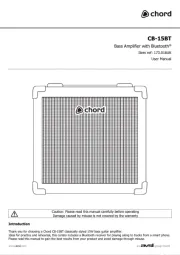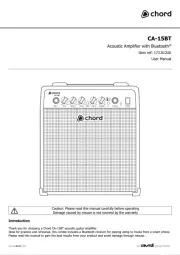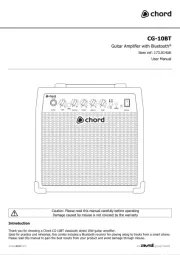General operation,
and specifications
4.0
Chord Electronics
Qutest | Manual
_
Chord Electronics
Product Communication | English
_
The Pumphouse Farleigh Lane,
East Farleigh, Maidstone
ME16 9NB United Kingdon
info@chordelec tronics.co.uk
chordelectronics.co.uk
Qutest
Manual
_
V.2.0
Tap length WTA1 16FS filter 49,152 taps
Elements 10 Element Pulse Array Design
Frequency response 20Hz - 20kHz +/- 0.2dB
Dynamic range 124dB A-Weighted
THD 0.0001% 1kHz 2.5v RMS 300Ω
Channel separation 138dB at 1kHz 300Ω
Noise floor modulation None measurable
Dimensions 41mm (H) x 160mm (W) x 72mm (D
Weight 770g
chordelectronics.co.uk
_
Drivers
Qutest is compatible with a wide variety of devices, including Mac OS
X, Windows, Linux, iOS and Android systems. Drivers are required for
Windows-based operating systems and these can be located on the
product page on the Chord Electronics website: chordelectronics.co.uk
Start-up sequence
Upon connection to power, Qutest will perform a start-up sequence evident
by the internal sample rate indicator cycling through a series of rainbow
colours. This will take approximately 16 seconds. During this time, Qutest
may not be discoverable, or output any audio. As mentioned, Qutest
automatically remembers last-used settings including Filter, Input, and Line
Level selection.
NOTE: When the correct input is selected on Qutest and the device
successfully detects an incoming signal the sample rate indicator will
illuminate (located within the viewing porthole).
Galvanic isolation
Galvanic isolation involves isolating the power rails of the data USB input,
allowing for greater sonic performance. Qutest features a Class 2 Type-B
USB input with this protection. No special attention or cables are required
to allow Qutest to function.
NO SOUND? Make sure that you have correctly selected Qutest as the
digital audio output on your machine. When plugging Qutest into your
computer, Qutest may not immediately or automatically be selected. For
more help please visit: chordelectronics.co.uk/get-support
Qutest must be connected to a device capable of attenuating its output
before being used. Connecting Qutest directly to a power amplifier can
cause irreparable damage to your equipment and your hearing.
If you require any help or advice, we first recommend contacting your
original dealer. They will have the best understanding of your system
and will be able to oer you bespoke advice. If you require further
assistance please visit the support page of the Chord Electronics website:
chordelectronics.co.uk/get-support
Specifications




















